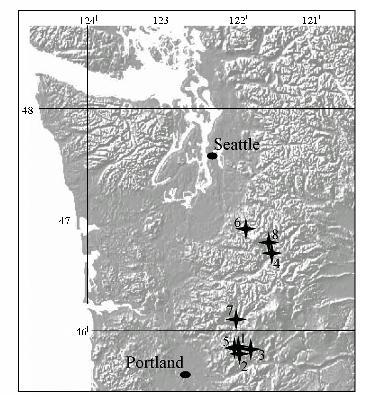One Thousand Year Chronosequence Study (1KCS)
Field Sites of the One Thousand Year Chronosequence Study (1KCS)
Eight forest stands were selected for this project, half of which were within the Wind River Experimental Forest (WREF). Several age classes of forest exist in this region, all derived from fire dynamics. Study sites were limited to Experimental Forests, Research Natural Areas (RNAs), or Mt. Rainier National Park.
Four of the chosen stands were within the WREF, including the old-growth stand at the Wind River Canopy Crane Research Facility. Three of these were the sites of detailed research on the effects of canopy gaps on the understory environment and were chosen for their extensive, undisturbed conditions (Spies et al. 1990). Four other stands, in structural stages not well represented in the WREF, were chosen to fill out the structural developmental sequence. Three of these sites were selected from the permanent plot network database held at Oregon State University, all of which are located at Mt. Rainier (Franklin and Van Pelt 1990, Acker et al 1998b). These are permanent, mapped research plots established in the 1970's. They are resampled every 2-3 years to document population dynamics, growth and yield, and the spatial pattern of mortality. One stand (Cedar Flats RNA) was chosen to represent the most structurally complex forest within the Cascadian forest biome. Information concerning site history from natural and human disturbances was taken from previous studies in these areas, with ecologists familiar with the site and our own experience (Topik et al 1986, Franklin et al 1988, Van Pelt 1995, Acker et al. 1998b). Preliminary reconnaissance in the area produced preliminary descriptions and visual representations of the stands (see below).

For detailed information on each of the eight chronosequence
sites, including information for researchers wishing to use the sites
to collect their own data, previously collected data for the sites,
etc. visit http://acdrupal.evergreen.edu/studycenter/1kcs.
Site 1 – Wind River Experimental Forest – Plantation (PL)
This
site represents the youngest stand, which also has the simplest
structure. It is a naturally regenerated Pseudotsuga stand that
developed following clearcut logging during 1952. The stand is fully
stocked and has had some partial thinning throughout some areas; the
latter were not included in our measurements.
Site 2 – Wind River Experimental Forest – Martha Creek (MC)
This
site resulted from the Yacoult burn, a 70,000 ha fire that occurred
during the fall of 1902. The combination of the surviving individual
trees and an abundant seed year allowed rapid establishment of a new
Pseudotsuga stand. Some of the area has had snag felling near the
roads, but the stand has never been salvage-logged or thinned.
Site 3 – Wind River Experimental Forest – Panther Creek (PC)
Panther
Creek is a tributary of Wind River that is situated on the east side of
the Wind River Valley. Much of this area burned during a fire or series
of fires around 1845. The tree canopy is nearly pure Pseudotsuga, with
shade-tolerant species present in places. The understory consists of a
dense layer of shrubs and small trees.
Site 4 – Mt Rainier National Park – Ohanapecosh (OH)
The
southeast corner of Mt. Rainier National Park, in the vicinity of the
Ohanepecosh Campground, contains examples of ca. 280 year-old
Pseudotsuga/Tsuga forest. While considered old-growth (Franklin and
Spies 1991b), this particular stand still has the two-layer canopy
characteristic of a younger stand.
Site 5 – Wind River Experimental Forest – Trout Creek (TC)
The
old-growth forests at Wind River are dominated by Pseudotsuga and
Tsuga. There is no evidence of major fire episodes at the site since at
least 1600, and stumps in the vicinity indicate that some trees were
more than 500 years old when cut in the 1970’s (Franklin and Waring
1980). The study site is characterized by gently sloping terrain on the
lower slopes of Trout Creek Hill, an extinct Quaternary shield volcano.
Site 6 – Mt. Rainier National Park – Carbon River (CR)
The
forests along the Carbon River are among the few remaining examples of
low elevation alluvial old-growth Pseudotsuga/Tsuga forest. Even though
the oldest trees are in the 350-500 year range, the stem density is
dominated by Tsuga. The understory is characterized by dense, rank
growth of mosses, ferns and shrubs.
Site 7 – Cedar Flats Research Natural Area – Cedar Flats (CF)
Cedar
Flats RNA was protected for its representation of Cascadian Thuja
swamps. The non-wetland parts of the area are dominated by
Pseudotsuga/Tsuga forest. These stands are 600-650 years old and are
among the tallest, densest and most structurally diverse known. The
individual structures in the crowns of these massive trees support
abundant epiphyte communities.
Site 8 – Mt. Rainier National Park – Chinook (CH)
This
site represents the oldest member in this sequence and the apparent
endpoint of Pseudotsuga development. The current forest originated
approximately 950 years ago. The structure of the canopy has been
simplified relative to the Pseudotsuga-dominated stands of the
old-growth at Wind River, Carbon River, and Cedar Flats to one with
only a few remaining Pseudotsuga and the regenerating shade-tolerant
species now dominant at the site.
Publications and data referencing the 1KCS:
Development of canopy structure in Pseudotsuga menziesii forests in the southern Washington Cascades (PDF)
Other
- For data and visualizations associated with the 1kcs sites, please visit the StudyCenter webpage at: http://acdrupal.evergreen.edu/studycenter/1kcs
- View the 1KCS sites in Google Earth

